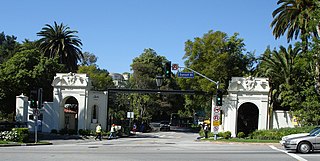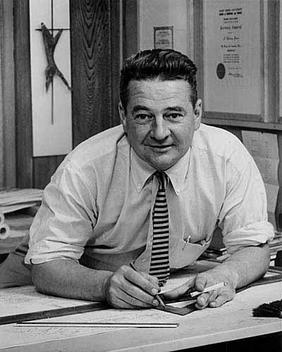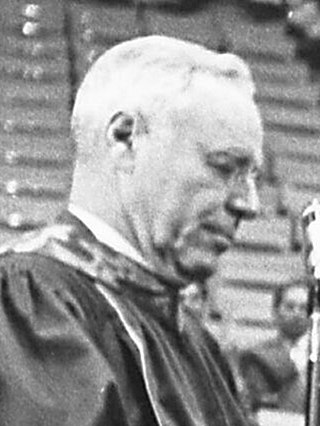
The University of California, Los Angeles (UCLA) is a public land-grant research university in Los Angeles, California. Its academic roots were established in 1881 as a normal school then known as the southern branch of the California State Normal School. It was absorbed with the official founding of UCLA as the Southern Branch of the University of California in 1919, making it the second-oldest of the ten-campus University of California system after the University of California, Berkeley.

Bel Air is a residential neighborhood on the Los Angeles Westside, in the foothills of the Santa Monica Mountains in the U.S. state of California. Founded in 1923, it is the home of the Hannah Carter Japanese Garden and the American Jewish University.
The Los Angeles Westside is an urban region in western Los Angeles County, California, United States. It has no official definition, but sources like LA Weekly and the Mapping L.A. survey of the Los Angeles Times place the region on the western side of the Los Angeles Basin south of the Santa Monica Mountains.

The Palos Verdes Peninsula is a peninsula and sub-region of the Los Angeles metropolitan area, located within southwestern Los Angeles County in the U.S. state of California. Located in the South Bay region, the peninsula contains a group of cities in the Palos Verdes Hills, including Palos Verdes Estates, Rancho Palos Verdes, Rolling Hills and Rolling Hills Estates, as well as the unincorporated community of Westfield/Academy Hill. The South Bay city of Torrance borders the peninsula on the north, the Pacific Ocean is on the west and south, and the Port of Los Angeles is east. As of the 2010 Census, the population of the Palos Verdes Peninsula is 65,008.

Archibald Quincy Jones was a Los Angeles–based architect and educator known for innovative buildings in the modernist style and for urban planning that pioneered the use of greenbelts and green design.

Alphonzo Edward Bell Sr. was an American oil multi-millionaire, real estate developer, philanthropist, and champion tennis player. The westside Los Angeles residential community of Bel Air is named after him, as well as the Southern California communities of Bell and Bell Gardens.
Nagao Sakurai (桜井長雄) of the Imperial Palace of Tokyo was a landscape architect.
Edwin Wallace Neff was an architect based in Southern California and was largely responsible for developing the region's distinct architectural style referred to as "California" style. Neff was a student of architect Ralph Adams Cram and drew heavily from the architectural styles of both Spain and the Mediterranean as a whole, gaining extensive recognition from the number of celebrity commissions, notably Pickfair, the mansion belonging originally to Mary Pickford and Douglas Fairbanks.
The history of the University of California, Los Angeles traces back to the 19th century when the institution operated as a teachers' college. It grew in size and scope for nearly four decades on two Los Angeles campuses before California governor William D. Stephens signed a bill into law in 1919 to establish the Southern Branch of the University of California. As the university broke ground for its new Westwood campus in 1927 and dissatisfaction grew for the "Southern Branch" name, the UC Regents formally adopted the "University of California at Los Angeles" name and "U.C.L.A." abbreviation that year. The "at" was removed in 1958 and "UCLA" without periods became the preferred stylization under Chancellor Franklin D. Murphy in the 1960s. In the first century after its founding, UCLA established itself as a leading research university with global impact across arts and culture, education, health care, technology and more.
Holmby Hills is a neighborhood on the Westside of Los Angeles, California, United States.

The Harold Lloyd Estate, also known as Greenacres, is a large mansion and landscaped estate located in the Benedict Canyon section of Beverly Hills, California. Built in the late 1920s by silent film star Harold Lloyd, it remained Lloyd's home until his death in 1971.

Arnold Sigurd Kirkeby was an American hotelier, art collector, and real estate investor. He is now best known for owning Chartwell Mansion in the Los Angeles neighborhood of Bel Air which was the exterior set for the CBS television show The Beverly Hillbillies.

Rancho San José de Buenos Ayres was a 4,438-acre (17.96 km2) Mexican land grant in present day Los Angeles County, California given by Governor Micheltorena in 1843 to Maximo Alanis. The area that was given to Alanis now occupies Westwood, UCLA, Holmby Hills, and Bel Air, Los Angeles. The ranch extended from what is now Sepulveda Boulevard to Beverly Hills.
The Kronish House is a 7,000 square foot villa designed by Richard Neutra in 1955. The house is located on 9439 Sunset Boulevard in Beverly Hills, California in the United States. The house was designed for Herbert and Hazel Kronish.
Koichi Kawana was a post-war Japanese American garden designer, landscape architect and teacher. He designed gardens in San Diego, Los Angeles, Denver, Colorado, Chicago, Illinois, Memphis, Tennessee, and St. Louis, Missouri. Some of his major works include the Seiwa-en Japanese Garden in the Missouri Botanical Garden, the Hannah Carter Japanese Garden and a dry landscape garden at Sawtelle, Los Angeles. He designed the bonsai collection for the Pavilion of Japanese Art at LACMA in the 90s.

Edward W. Carter was an American businessman, philanthropist and art collector. He served as the president of Broadway Stores and chair of the University of California Board of Regents, and was the owner of the Hannah Carter Japanese Garden.
A. E. Hanson (1893–1986) was an American landscape architect and real estate developer in Southern California. He designed gardens on the campus of the University of Southern California as well as in Bel Air. He developed two gated communities near Los Angeles, California: Rolling Hills and Hidden Hills.
Richard Dorman was a mid-century modern architect known for his residential and commercial work in Southern California.

The Wilshire Regent is a 23-story, 92.47 m (303.4 ft) full service condominium skyscraper in the Wilshire Corridor section of Westwood, Los Angeles, California and the 103rd tallest building in Los Angeles.
The Pritzker Estate is a private residence located at 1261 Angelo Drive in the city of Los Angeles, in which the structure ranks as the second largest private residence. This is also the third largest home in the entire Los Angeles metropolitan area. The enormous mansion was built between 2005 and 2011 for billionaire Anthony Pritzker, one of several heirs to the Hyatt Hotel fortune. Located in the exclusive Beverly Crest neighborhood, the gargantuan home has been dubbed the "Grand Hyatt Bel Air" by disapproving neighbors, in reference to its extraordinary size.











